In the 2010 World Championship match, Vishy Anand went into the final game deadlocked with Veselin Topalov. It seemed as if the best he could hope for was a tie and a playoff… but then he unexpectedly ended the match with a stirring victory as Black!
Could history repeat itself? Could Anand pull out another final-game miracle? Well, if you read my last post you already know the answer. But whether you know what happened or not, I’m sure that you will find GM Sergey Shipov’s comments as astute as always. The original commentary, in Russian, is at www.crestbook.com. — DM
Hello, dear friends. I invite you to watch the concluding game of the world championship match with me, grandmaster Sergey Shipov. The score is tied, and the pressure has reached its apogee, the whole chess world is watching at its computer monitors! The contestants, on the one hand, passionately desire to win the title, but on the other hand, I’m sure that they are dreaming of ending the battle as soon as possible, letting go of the weight of responsibility. The day off before this game was probably a torture for them. The seconds polished their opening variations, while Vishy and Boris vaintly struggled to get at least a few hours of sleep in a row. In principle, twelve games is not a long distance. There should still be a reserve of physical strength in both fighters, but whether they still have enough nervous energy — we’ll have to see. My prediction is that somebody at some moment will lose concentration and will play nervously, impulsively and recklessly. If you remember, that is exactly what happened to Topalov in the very same twelfth round of the championship match with Anand in May 2010. At that time, Veselin made a pair of sharp attacking moves (which he himself could hardly explain later) in a roughly equal position, and as a result he was demolished by Vishy’s counterattack. Of course, no one would want to repeat the Bulgarian grandmaster’s mistake, but wishes alone aren’t enough…
I ask myself a direct question: will we have a decisive game today? A draw, in my opinion, is no less likely. Especially because Vishy is traditionally good at rapid chess and blitz, he has no particular reason to strive for a victory at all costs. If he doesn’t get a palpable advantage from the opening or if he encounters a strong novelty, then it’s quite probable that the battle will be cut short…
I predict that we will see the Grunfeld Defense again and will see a new attempt by White to present a surprise at an early stage, far from the most topical variations. But of course, Gelfand will expect exactly this. So… anything is possible! Let’s just watch and cheer. May the best man win.
(1) Anand,Viswanathan – Gelfand,Boris [B30]
World Championship Match (Game 12), 28.05.2012
[Shipov, Sergey (translated by Dana Mackenzie)]
1.e4
As it turns out, the world champion’s camp was not able to find a refutation of the Grunfeld Defense. Peter Svidler can be satisfied.
1…c5
The Sicilian Defense has served Gelfand well for his whole career and in particular in this match.
2.Nf3 Nc6 3.Bb5
Again the Rossolimo Variation, as in the tenth game.
3…e6 4.Bxc6 bxc6 5.d3
A local surprise. But at the same time the main theoretical move. [Apparently Anand was disappointed by the variation 5.b3 e5!]
5…Ne7
A flexible strategy in the spirit of Philidor’s philosophy. Black’s central pawns, including the one on f7, can move forward, depending on what White does. It’s very important not to allow a complete blockade of the center and to give the bishops some room to operate. For example, with the pawn on d7 Black is prepared to meet the advance e4-e5 with the disrupting … f7-f6.
6.b3
An interesting and non-standard move order. It was first used by Boris Spassky in a game with Boris (yes, another Boris) Gulko in 1990. The suspense in the position has to do with the question of whose pawn will move to e6 first. Boris (the third, the younger) is thinking a long time, trying to remember, comparing lines. Of course, besides the known answer 6. … Ng6 he is considering 6. … d6 with the idea of … e6-e5. [6.Qe2 is the most commonly played move for White, and I simply must give as an example a game played by the world champion himself: 6…Qc7 7.Ng5 h6 8.Nh3 g6 9.f4 Bg7 10.c4 e5 11.Nc3 d5 12.0–0 0–0 13.g4 exf4 14.Bxf4 Qd7 15.exd5 cxd5 16.Rae1 Nc6 17.Nxd5 Nd4 18.Qg2 Qxg4 19.Ne7+ Kh7 20.Nxc8 Qxg2+ 21.Kxg2 Raxc8 and the chances of both sides turned out to be equal in a complicated endgame, R. Ponomariov – V. Anand, Linares 2003.]
6…d6
As strange as it may seem, a novelty! [First of all let me show the original game: 6…Ng6 7.Bb2 f6 8.e5 Be7 9.Nbd2 0–0 10.0–0 fxe5 11.Nxe5 Nxe5 12.Bxe5 d6 13.Bg3 e5 14.Qe2 (14.f4 was tried later, without much success) 14…Bg5 15.Ne4 Bh6 16.f3 a5 17.a4 Ra7 18.Bf2 Raf7 19.Be3 Bxe3+ 20.Qxe3 h6 and Black has completely equalized, B. Spassky – B. Gulko, Linares 1990.]
7.e5
A principled objection, and it would seem, a pawn sacrifice.
7…Ng6
He couldn’t make up his mind to take the pawn! [The path of accepting the present seems more important to me: 7…dxe5 8.0–0 (8.Nxe5 Qd4!) 8…f6 9.Nc3 Nd5 10.Ne4 Be7 11.Ba3 and … I don’t see what White does to develop his initiative. Of course, the champion knows better. After all he undoubtedly has come to battle with a stone hidden in his pocket.]
8.h4
A brilliant attacking move! Vishy is showing his fighting mood. He literally insists on the loss of his own pawn at e5. [8.exd6 does not look good for the following reason: 8…Qf6 9.c3 Bxd6 , after which both sides have flaws in their pawn structure; 8.Bb2 looks more to the point, but I found a problem with it as well, namely 8…dxe5 9.Nxe5 Nxe5 10.Bxe5 Qd5! with a fork on e5 and g2.]
8…Nxe5
The challenge is accepted. [The cowardly answer 8…h5 does not lose right away, but it was bad on positional grounds. After Black develops his bishop on f8 and castles short, the pawn on h5 could die at the hands of White’s queen.; 8…Be7 also cannot be recommended, if only because of 9.exd6 Qxd6 (9…Bf6 10.Bg5) 10.Na3 with palpable pressure for White across the entire battlefield]
9.Nxe5 dxe5 10.Nd2
Black has snagged an extra pawn, but White has a lasting initiative. He has prospects of winning back the pawn on c5, but Boris is most likely more concerned with the activity of his opponent on the kingside. Notice how quickly Vishy is playing — he is still following his prepared variations. I will pronounce the first small, local victory for the champion’s forces — he has managed to get the jump on his opponent and force the challenger to work over the board at a very early stage. There is already no question of an early draw in today’s game, we can expect a serious battle! The clock shows 1:55 – 1:27. Gelfand cannot make up his mind. This is a very unpleasant moment for him. Black has no obvious counterplay, and it’s not even clear at the moment what threats he should be defending. And time pressure is lurking in the distance… I suspect that the Israeli grandmaster is looking for some kind of cardinal decision, some way of radically changing the position, to confuse his opponent. It’s possible that he is considering the return pawn sacrifices … c5-c4 or … e5-e4, which give Black hope of reviving his passive bishop on c8.
10…c4
My premonitions did not deceive me! Boris did not want to defend passively for many moves in a row. Even the hint of a possible initiative for Black is balm to his soul. On either capture by White on c4, Black will soon play … c6-c5 and the bishop will achieve freedom on the long diagonal. In case of the most likely capture with the knight, the continuation … Bc8-a6 with the intention of trading on c4 also looks interesting. For the first time in the game Vishy is looking at the board with interest. A chance has finally turned up for him to think about something… He has more than enough time: 1:44 – 0:59. [There were multiple scenarios for more restrained play. Here are my first sketches: 10…Be7 11.h5 h6 12.Qg4 0–0 13.Bb2 f6 14.Nc4 Qe8 15.Rh3 Bd8 (15…Qf7 16.Rf3!) 16.Kf1 Bc7 17.Re1 Ba6 18.Ba3 Qe7 19.Rg3 Rf7 20.Qe4 and one way or another White wins back the pawn, retaining an initiative; 10…Qd4 is a second variation: 11.Rb1 Qd5 12.Qg4 f6 13.0–0 Kf7 (the bishop on f8 cannot be moved for the moment because of the weakness on g7) 14.Ne4 Be7 15.Qh5+! Kg8 16.Be3 after which the pawn on c5 will quickly succumb. It’s important to realize that Black cannot transfer his bishop from c8 to e8 in view of 16…Bd7 17.c4 Qxd3 18.Rbd1 Qxe4 19.Rxd7 with decisive threats for White; 10…e4 was another way of pitching the pawn back, but it has a small defect: 11.Nxe4 e5 12.Qh5! and Black doesn’t have a civilized way to defend his e5 pawn — 12…Bd6 13.Bg5 (13.Ba3 0–0 14.0–0! is also not bad) 13…Qc7 (13…Be7!? 14.Bxe7 Qxe7 15.f4 exf4 16.Qxc5 with a clear advantage for White) 14.0–0 with the idea 14…0–0? 15.Nf6+! followed by mate.]
11.Nxc4
This move hardly deserved such long hesitation, because the captures with the pawns were clearly worse. Apparently Anand was simply thinking about the future… [For example, 11.dxc4 is unattractive for White after 11…Qd4 12.Qf3 Bb7 13.c3 Qf4 14.Qxf4 exf4 15.Ne4 e5 and everything is in order for Black.]
11…Ba6
Just so. Gelfand politely offers his opponent the present of a pawn at e5… [On 11…Bb7 he might not have liked 12.Qh5 and the pawn on e5 will soon die, as the White queen does not allow the pawn on f7 to support its comrade. None of the variations give Black much hope: 12…Qd5 13.Bb2!? (with the idea of castling long) 13…Bb4+ 14.Kf1 0–0 (14…c5 15.f3!) 15.Qxe5 f6 16.Qe2 and it does not look as if Black gets real compensation for his pawn.]
12.Qf3
Anand answers with an attack on the c6 pawn. [I don’t care how much nervous pressure there is, it was impossible to expect White to blunder a piece with 12.Nxe5? Qa5+!]
12…Qd5
As one should have expected! Boris, in essence, intends to trade places with his opponents. Only two moves ago he had an extra pawn and the prospect of being subjected to the pressure of the opponent’s initiative, but now he himself is striving for a position a pawn down with possible compensation… Black’s two bishops have good prospects, and if he manages to open the position a little bit, his initiative will become a reality. [Passive measures would have allowed White to retain some pressure: 12…Rc8 13.Qg3 Bxc4 14.dxc4 Bb4+ 15.c3 Qd4 16.Bd2 Qe4+ 17.Kd1! Bf8 18.Re1 Qf5 19.Rxe5 Bd6 20.Rxf5 Bxg3 21.Ra5 Bxf2 22.Ke2 Bb6 23.Ra6 followed by the advance of a phalanx of queenside pawns.]
13.Qxd5
Vishy did not hesitate for long. [However, the unyielding 13.Qg3! , with threats on the e5 and g7 points, deserved serious attention.]
13…cxd5 14.Nxe5
Black has repaired his pawn structure. Now he must attack!
14…f6
[14…Rc8 would be premature because of 15.c4]
15.Nf3 e5
Beautiful! Thep awn at c2 can now become the target of attack by Black’s rook, and if c2-c4 White must reckon with the shot … e5-e4, blowing up the center.
16.0–0
[Even so, I briefly looked at the continuation 16.c4 e4 17.dxe4 dxc4 18.0–0 and now if 18…cxb3 19.Rd1 White can claim an advantage in view of his large lead in development. But it’s possible that the champion did not like 18. … c3!?]
16…Kf7
Sensible prophylaxis. Its point is revealed in the variation [16…Rc8 17.c4 e4 18.Re1!]
17.c4
Just the right time.
17…Be7
Boris is handling this part of the game well. Quickly and with high quality! The advantage of the two bishops clearly gives Black chances for a positive result from any future endgame. I have a suspicion that Vishy settled for too little with his trade of queens on d5. He was tempted by the extra pawn and presented his opponent a very pleasant position to play. [Now the move 17…e4 is no longer effective, for example, 18.dxe4 dxc4 19.bxc4 Bxc4 20.Rd1]
18.Be3
With this move the champion is trying to provoke the advance … d5-d4, which would stabilize the pawn structure. It’s unlikely that the challenger will accept the invitation… On the other hand, it’s worth pointing out the harmful effects of the move h2-h4 in this situation. Pawns don’t move backwards. It’s possible that Black can create some complications on the kingside. The clocks read 0:59 – 0:40.
18…Bb7
Once again a strong move. Black’s white-squared bishop applies serious pressure on White’s position. If he can open even one rank on the right side of the board, White will be under attack. Another idea is to open the queenside with the moves … a7-a5-a4. It seems that Black has no reason to complain about his life. And what is White to do? Breaking in the center is dangerous, because the Black bishops would run rampant. Apparently he must try to activate the queenside, where he does after all have an extra pawn.
19.cxd5
Playing for simplifications. [I, not being at any personal risk (after all, I’m not one of the players sitting at the board in the Tretyakovsky Gallery), looked for a while at the risky variation 19.a3 a5 20.Bb6 Rhc8 21.Rfc1 with the intention of … no, never mind. There are no clear plans for White here. Any active measure has something wrong with it.]
19…Bxd5
The bishop aims at both sides of the board with terrifying power. The pawn deficit has no significance for Black. The only chance I can see for White is a trade of dark-squared bishops on c5, but who will let that happen…
20.Rfc1
The rook aims for c7 and is ready to support the move Be3-c5. Also there is an idea of transferring the knight through d2 to either e4 or c5. Or via c4 to b6, after the likely … a7-a5. However, it is unlikely that Black will sit and do nothing. He has every right to attack the d3 pawn…
20…a5
… or organize the break … a5-a4.
21.Bc5
Exchanges are on the horizon. In principal, a complete liquidation of minor figures would promise Black a decent endgame, with many weak pawns in the White camp. As is well known, one of the advantages of the two bishops lies precisely in the fact that you can trade them off at the necessary moment. Let’s take a look at the clock along with Gelfand: 0:55 – 0:23. [On 21.Nd2 Black plays 21…a4! with good counterplay; 21.Rc7 did not lead to any advantage because of 21…Rhc8 22.Rac1 Rxc7 23.Rxc7 Ke6 and again the pinprick … a5-a4 is on the agenda.]
21…Rhd8
As far as I can tell, Boris simply was reluctant to part with his gorgeous bishop on d5. Spending all this time in the Tretyakovsky Gallery has strengthened his aesthetic instincts! [21…Bxc5 From the practical point of view it would be simpler to play 22.Rxc5 Bxf3 23.gxf3 Rhd8 and, for example, 24.Rc7+ (24.Rd1 Rd4 25.h5 Ra7 26.Rc4 Rd5 and … Ra7-d7, as well as … Kf7-e6-f5) 24…Kg6 25.Kh2 Rxd3 26.Rg1+ Kf5 27.Rgxg7 a4! and the contours of a draw are becoming apparent.]
22.Bxe7
and here Anand somewhat unexpectedly OFFERED A DRAW, which Gelfand quickly accepted. [22.Nd2 was no worse, in effect telling Black to go ahead and trade bishops on c5.] A possible continuation was 22…Kxe7 23.Nd2 a4 24.Rc7+ Kf8! 25.b4 a3! and Black’s counterplay is not bad. What can I say? It’s easy to understand the champion’s decision. One can’t say that playing for a win in the final position would be free of risk. Quite the opposite! The game just completed must be considered disappointing for Anand. In the opening he achieved a promising position and an hour time advantage — what more could you possibly want? Gelfand held himself together like a champion with a fine sense of psychology. He correctly returned the extra pawn, and then provoked his opponent, tempted him with another pawn sacrifice, seized the initiative and escaped with only a mild scare. And so, the regulation time of the match has ended. The score is tied, 6-6! Now we await a tiebreaker consisting of four games of rapid chess and an unlimited number of blitz games in case of a 2-2 tie. This feast of chess and trial of the opponents’ nerves will begin the day after tomorrow at 12:00 Moscow time, three hours earlier than usual. I will try to think about how I can comment on this event…Please send in your own suggestions, dear readers, to the KasparovChess forum [on the Crestbook website — DM]. This has been grandmaster Sergey Shipov with you. Thank you for your attention, and I’ll see you soon!
½–½
Download PGN here.
Note to my readers (this is DM again): As you can see from the above, it remains uncertain whether GM Shipov will comment on the tiebreak. In any case, I will not translate his annotations, if they exist, because everything will happen in the dead of night California time. In any case, it’s hardly likely that there will be time for meaningful comments and translations during a rapid game, to say nothing of a 5-minute game (if the tiebreak gets that far). You should check at Chess in Translation to see if Colin McGourty (aka MishaNP) has any plans for translating the playoff.
As a separate issue, I’m sure that anyone who has read this blog before knows that I think it’s a ridiculous idea to decide a world champion by blitz games. To me, it devalues the whole concept of a world champion. But in some sense it would be the logical culmination of this whole strange World Championship cycle, with a candidates’ tournament that was full of draws and rapid-chess playoffs, and a championship match that was just the same.
Thanks again to all of you who read my translations. In spite of the need to get up early, I have had a lot of fun, and I hope you have, too!
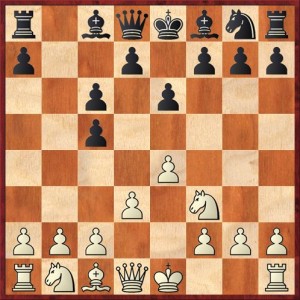
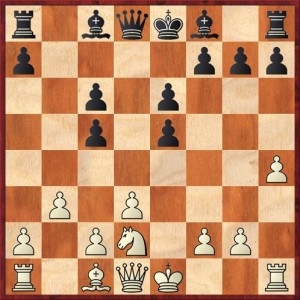
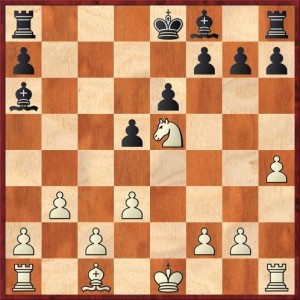
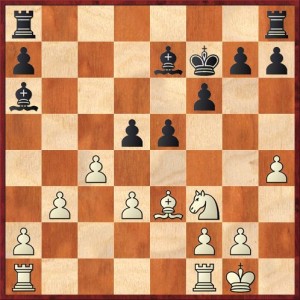
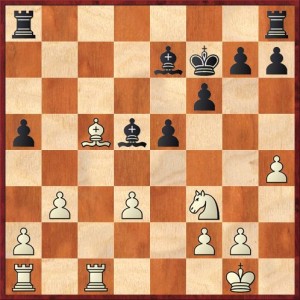



{ 1 comment… read it below or add one }
Thanks for all your work Dana!